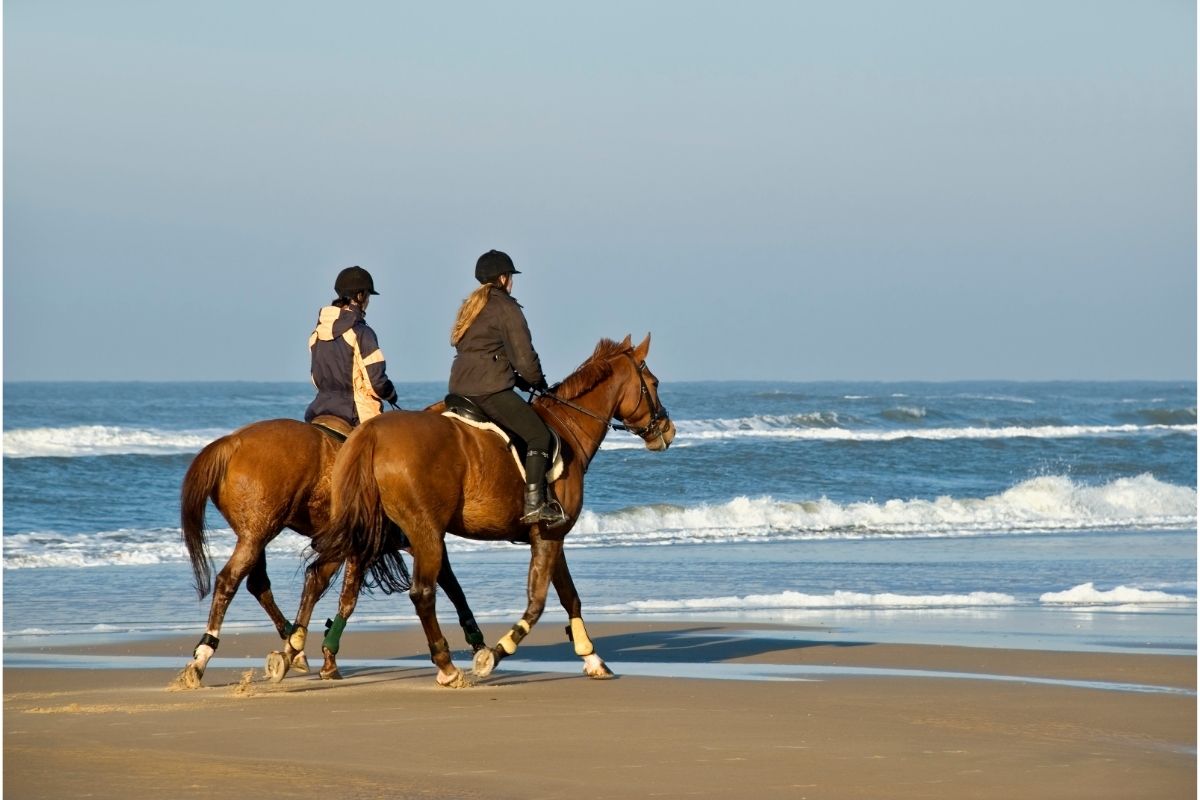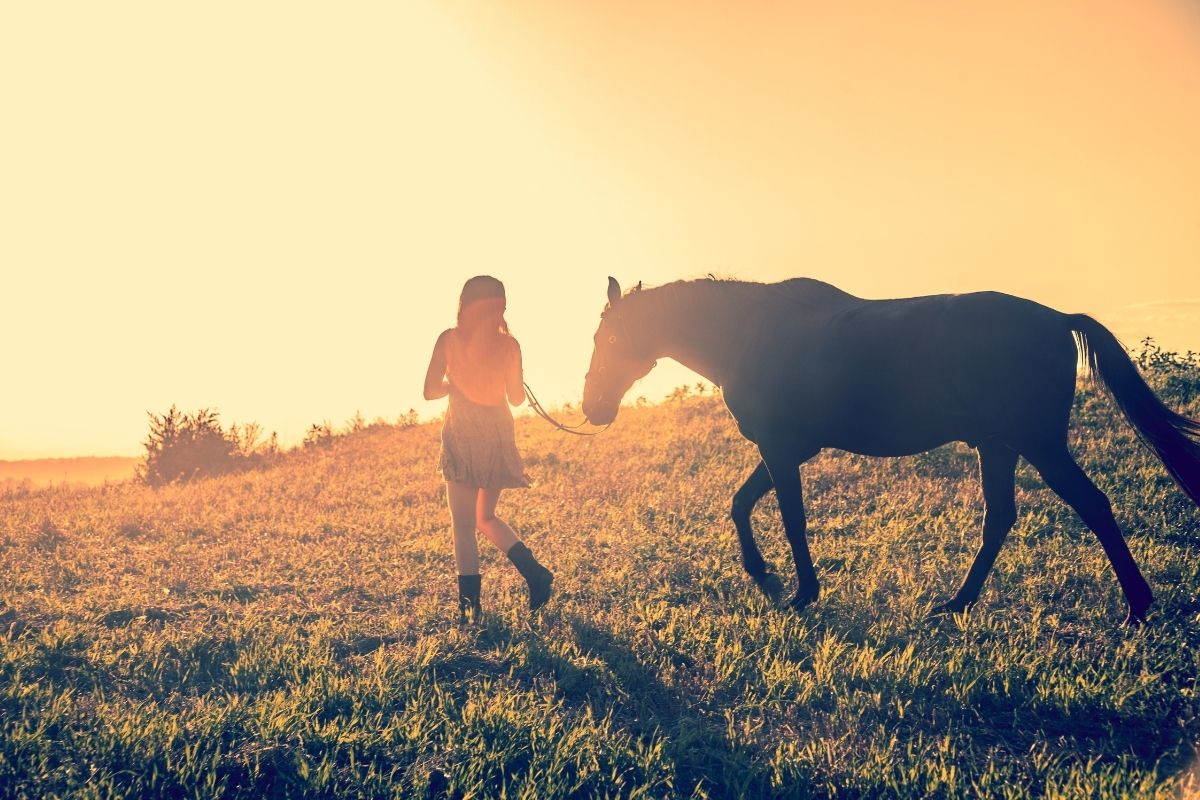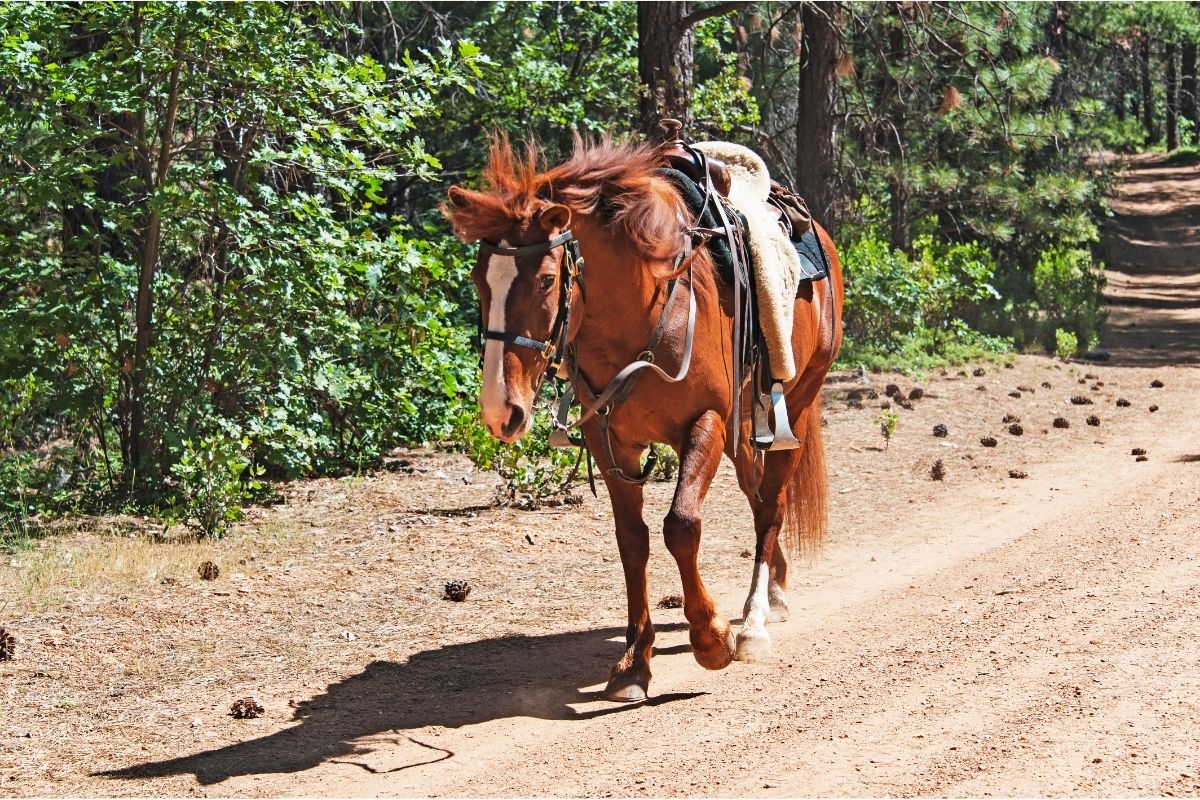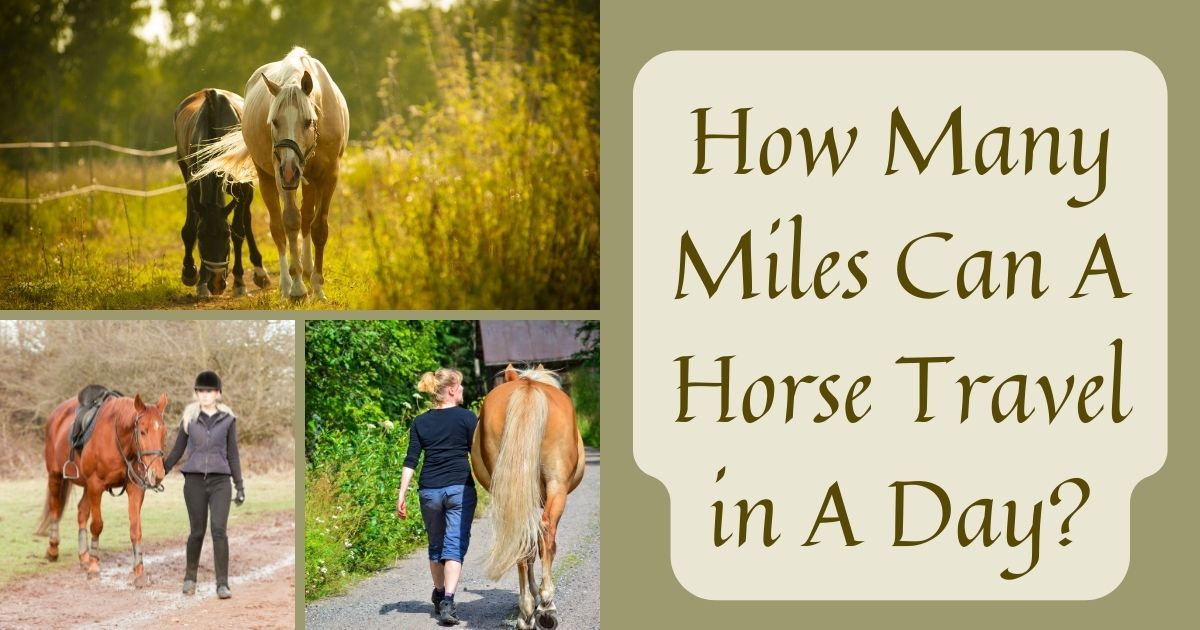Horses and Daily Travel Time
How many miles can a horse travel in a day? There is no specific answer to how far a horse can ride in a day because no two horses are the same. First, understand that a horse’s legs move in three ways: the slowest gait, the quickest trot, and gallop.
Second, several factors, including the horse’s breed and age, influence how much a horse can traverse during the day.

The History of Horse Travel
A good number of species of horses inhabited the Great Plains of North America 10 million years ago. These ancestors of the modern horse come in various sizes and shapes. Some were living in the woods, while others were in open grassland.
The first members of the horse family, the dog-sized Hyracotherium, were scampering through the forests of North America 55 million years ago. Most horses were minor forest browsers for more than half of their existence. However, change in climate conditions, grasslands expanding, and many new species were emerging quickly around 20 million years ago.
Some, but not all, were developing the characteristic hooves and grazing diets that we now identify with horses. Only these species still exist today, even though small and giant species coexisted in the past.
How Many Miles Can a Horse Travel in a Day?
How far can a horse travel in a day? If you properly train and equip horses, they can travel thousands of miles. Just don’t put too much pressure on them.
Horses traveling for more prolonged periods travel slower than horses on a one-day trip. Groups always on horseback for weeks, such as calvary, frequently travel 20 to 30 kilometers (12.42 to 18.64 miles) every day.
On the other hand, horses that travel for one-day can quickly go 50 to 60 miles (80.46 to 96.56 kilometers), but the animal may not be able to handle another day of riding until it gets some rest for a day or two.
The Average Horse Travel Speed
A few crucial elements will influence your horse travel journey. The fitness and talents of both you and your horse are the essential items to consider.
You must rest enough, feed properly, and have sufficient water supplies. You should also double-check your gear, terrain, and weather conditions. Let’s have a look at what we have for traveling by horse.
Gait
The horse’s travel speed will determine the distance a horse can cover in a single day. The horse also determines the gait pattern.
Some people are born with efficient movements that allow them to travel quicker and further while using less energy. Furthermore, they provide a more comfortable ride for the rider. There are two sorts of gaits to be aware of:
Natural Walking Style
Walking, trotting and running are all examples. An essential natural walk is a four-beat gait that covers up to 4 mph (6.5 km/h). Regarding trotting, a horse can trot at about eight mph (13.9 km/h) while moving in a two-beat gait.
Ambling Stance
Cantering and galloping are two examples of natural and learning movements. The canter (lop) is a three-beat gait that permits a horse to travel at 10 to 17 mph (4.5 to 7.5 km/h). Regarding galloping, a natural or ambling gait in which a horse travels at around 30 mph (48.5 km/h).
How far can a horse walk in a day? The pace you choose for the ride determines the total distance a horse covers in a day. An average horse may be capable of walking for eight hours, covering 32 miles ( 51.4 kilometers) in that period.
However, many weekend warrior riders cannot endure eight hours in the saddle. If a horse can trot or canter for a portion of the journey, it will be able to cover a greater distance.
Footing and Terrain
How far can you ride a horse in a day? When deciding how far to ride each day, consider the terrain your horse will traverse. Your horse’s limbs and cardiovascular system work more when traveling up or down steep slopes than when traveling on level land.
Since the impact on your horse’s hooves and joints will be more if the terrain is hard or rocky, you should decrease the distance you go on such terrain and lower your pace. Deep mud or sand is more taxing on your horse’s tendons and ligaments than stable footing, so exercise caution in those conditions.
Climate Conditions
When planning your ride, keep the weather in mind. Sweating causes horses to lose a significant amount of body fluids and electrolytes. A horse’s health can deteriorate if it experiences dehydration or electrolyte depletion during a ride. Make frequent stops if the weather is scorching and humid.
When your horse is actively sweating during long rides, give him electrolytes. Sweat evaporates quickly in hot, windy weather with low humidity, so the horse will appear dry if it loses electrolytes and water through sweat.
During a ride, horses should always be willing to eat and drink. If your horse refuses to eat when you stop to offer a bite of grass, it’s probably tired and needs to rest for the day.
Overall Fitness and Health
Every rider in a group should set their pace and distance depending on the least fit horse. The joints of older horses may be a little arthritic. They may be willing to keep up with their younger trail companions, but they may feel tired after a long ride.
Horses extremely fit in with the other members of their herds and will go beyond what is safe to stay with them. It is the rider’s responsibility to keep a horse from overworking himself. Don’t let your horse overdo it on a long trail ride if he isn’t in a regular training program to improve his cardiovascular condition.
Tired horses are more likely to fall and damage themselves. Maintain a calm and comfortable pace while taking in the landscape and the company of your fellow riders.
Modern Horse Pace vs. Olden Times
Remember that people nowadays use horses differently than they were hundreds of years ago. Because these animals no longer go on long daily treks, they adapt to their new surroundings.
How long would it take a horse to travel 100 miles (160.9 kilometers)? Unlike those training to perform everyday voyages in the past, modern horses are less capable of doing so, with a few exceptions. Olden times horses could cover about 35 miles (56.5 km) every day, but modern can only travel about 25 miles (40 km) per day.

Factors That Determine how far a Horse Can Travel
First and foremost, horses, even those of the same breed, function individually. Some animals, like humans, are outstanding athletes, while others are not. However, there are several generalizations that you can use to estimate how far horses can travel.
Fitness
A horse’s general health and ability to perform athletically is what we refer to as fitness. Following a regimen of good nutrition, proper exercise, and rest is what you require to achieve optimum fitness.
A horse’s fitness is vital to travel great distances; otherwise, it may suffer irreversible injury. When getting a horse in shape, proper training practices are essential. Humans train for a 0.06-mile (0.1- kilometer) dash differently from a marathon. Similarly, you prepare horses based on the distance and purposes for which you will use them.
By increasing muscle endurance, fitness training improves a horse’s ability to exercise. Improving the horse’s fitness is a process, and it can take a long time. However, a lot relies on the horse’s age and fitness level.
Prepare your horse for long-distance travel by conditioning him. To achieve this objective, consider the following aspects:
- Patience is crucial: Pushing your horse too hard will injure itself, delaying the animal’s training. Expect to train with your horse for a few months to get him in top shape for a long ride.
- Begin trotting your horse three times a week for roughly 45 minutes throughout the first month of training. Be careful to keep an eye on your horse and adjust the length and intensity of the exercise as per need.
- You don’t want to overstress the animal. Thus, your assessment is crucial. It’s preferable to cut back on training than to have to take time off due to lameness. Expect your horse should be able to trot comfortably for 45 minutes after the first month of training. You aim to raise the intensity and degree of your training during the second month.
- Include hills one day a week and speed up the pace one day to enhance the intensity. For seven kilometers, work your horse at eight miles per hour. After these workouts, keep an eye on your horses’ recovery period.
- Within ten minutes of finishing the exercise, your horse’s heart rate should rise to around 180-200 bpm, and once in shape, it should return to 60 bpm. On endurance rides, horses with lower heart rates quickly after exertion do better.
- You and your horse should be capable of a twenty-five-mile ride by the conclusion of your second month of training. This training schedule will help you and your horse develop the capacity to ride longer distances.
Gait
When a horse is walking, trotting, or cantering, its gait is the pattern of its leg movement. Some horses can move smoothly and efficiently. Specific gaits allow horses to travel further.
Horses with a more efficient stride travel further and expend less energy than horses who have a less efficient footfall pattern. A smooth gait is also more comfortable for the rider. Long-distance riders often coordinate their movements with their mounts, making long rides more bearable.
Tack
When riding your horse, properly fitting tack is crucial; this is especially true when traveling by horseback for long distances. Failure to fit the tack properly will cut the trip short, ensuring your saddle is the right size for your horse.
A saddle that you don’t fit properly might harm your horse’s muscles, tissue, and nerves. You should also make sure the saddle is comfortable because you will be sitting in it for several hours.
Use a bit that your horse is familiar with and you use in training. A long trail ride is not the ideal time to experiment with new gear. Also, keep an eye on your horse’s girth throughout the journey. During breaks, loosen it up and never overtighten it.
Water and Food
A horse given the correct quantity of energy (meal) and water will finish a lengthy ride faster and recover faster than a starving horse.
It’s vital to have access to water while on the trail. If your horse experiences dehydration, it may suffer severe and irreversible harm. If your horse is overheating, dismount and give it some water, the saddle, and other tacks. Allow time for the horse to cool down.
During training, it’s critical to feed your horse a good diet and provide it with continuous access to water. Before going on a long ride, get a veterinarian to check your horse. Let the Vet do blood work to make sure it is in good health and doesn’t need any minerals.
Terrain
How long would it take a horse to travel 20 miles (32.18 kilometers)? The trail terrain plays a vital role in deciding how many miles a horse can go in a day. Thirty miles of flat, clear paths are easier to handle and complete than thirty miles of rugged mountainous terrain.
The Difference Between a Day Trip and Consecutive Days
A healthy horse can go between 25 and 35 miles ( 40.23 and 56.32 kilometers) per day. You should cover this distance at a leisurely speed with hydration stops. However, asking a horse to maintain this speed for numerous days in a row might cause health concerns.
Backyard Horse vs. Seasoned Equine Athlete vs. Breeding
Classification of the majority of horses is into one of these three groups: breeder’s herds, backyard horses, or seasoned competitors.
- Breeder’s herds are horses in selective breeding programs to achieve specific breed qualities. These horses cover short distances, usually inside their pastures. The costs of producing foals year after year can hurt a brood mare’s ability to move. Building up to 25 miles (32.2 kilometers) in a day requires some conditioning.
- The backyard horses are horses that you treat as family members or pets. Sound and robust backyard horses may typically cover 15.53 to 21.74 miles (25 to 35 kilometers) per day. With some physical conditioning, fifty miles per day is possible. Before embarking on a 35-mile (56.32-kilometer) ride with a backyard horse, the rider must assess the horse’s physical condition.
- The seasoned competitor. These horses with conditioning and training to be the best in their fields. It makes no difference if the event is upper-level dressage, three-day-eventing, reigning, working cow horse, barrel racing, or other. These equine athletes receive the same level of attention and treatment as any human athlete.
How many miles can a horse travel in a day? Horses that experience training for endurance racing are excellent examples of how far a horse can travel in a single day. Endurance races can range in length from 50 to 100 kilometers (31.06 to 62.13 miles).
How Different Paces Will Affect Different Horses?
Horses can stroll or gallop at a set pace with a mile average speed. It varies based on the horse, the rider’s abilities, the terrain, and the weather.
As previously stated, a typical horse can walk at about four mph (6.5 km/h), trot at roughly 8 to 12 mph (13.9 and 19.5 km/h), and gallop at least 25 to 30 mph (40 and 48 km/h).
Never believe the famous movie sequences. Most average horses can only go 2 miles (3 kilometers) at a gallop before becoming exhausted and roughly 20 miles (32 kilometers) at a trot. When your horse walks steadily, you can ride it for between 25 and 35 miles (40 and 56.5 kilometers) without stopping.
An ordinary trail horse in good health can travel 50 miles (80.5 kilometers) in one day, whereas a fit endurance contender can travel up to 100 miles (161 kilometers). However, most of them can’t ride for more than a few days without taking two days off.
A more fit animal can cover much distance when trotting and cantering one part of the route. Keep in mind that there aren’t many riders who can keep up with that pace. On the other hand, some horses cannot ride for more than eight hours in a single day.
How to Condition a Horse for Endurance Outings
When determining if an equine athlete can travel 50 miles (80.46 kilometers) or more per day, we must consider the horse’s discipline. Is it necessary for the horse to have a short burst of high speeds, similar to a racehorse? Is it essential for the horse to move in controlled, precise steps like a dressage horse? Are they leaping over cross-country jumps to beat the clock?
The list goes on and on. Each discipline’s conditioning is relatively similar to a healthy horse. The most critical factor is proper diet, in which you add frequent exercise and a body conditioning program.
At the same time, each discipline has specific requirements for that discipline. Endurance conditioning necessitates a significant amount of time and particular attention to maintain the horse healthy throughout a 50-mile (80.46-kilometer) race.
Traveling on Various Terrains
The type of terrain you are planning to traverse can have a significant impact. It will be easier and faster to navigate the flat, vast ground than to navigate hilly or mountainous terrain.
Equip the Horse with the Right Gear
The correct fit of the equipment you use can significantly impact how far a horse and rider can go in a day. A poorly fitting saddle can result in serious deep muscle problems and unpleasant skin rubs. Problems might also arise from a bridle that is too tight or has a sharp bit.
Horses must wear the appropriate footwear for the terrain. Losing a shoe in the middle of a long ride can be a great way to shorten it. This is especially if the ground is rocky or if the horse has a soft foot.
It is also vital to have well-maintained equipment. It could be a long trek home if a billet strap breaks.
FAQs on Horse Pace
What is the Fastest 100 Mile Ever For a Horse?
Yousuf Ahmad Al Belushi, an eleven-year-old, achieved the record for a horse and rider crossing 100 miles (160.93 kilometers) in 5:45:44 seconds.
What Is Known As The Greatest Horseback Race in U.S History?
During the War of 1812, Sam Dale traveled 670 miles ( 1,078.26 kilometers) on horseback from Georgia to New Orleans in eight days to relay instructions from Washington, D.C. to General Andrew Jackson.

Parting Words
How many miles can a horse travel in a day? You can ride an average, healthy, and enthusiastic horse for between 25 and 35 miles (40 and 56.5 kilometers) in perfect conditions in one day. However, with proper water, food, and rest, most of them will be able to handle only 15 to 20 miles (24 to 32 kilometers) each day.
Keep in mind that the distance you travel, the weather, the terrain, and the equipment you utilize determines how far you can ride your horse.

